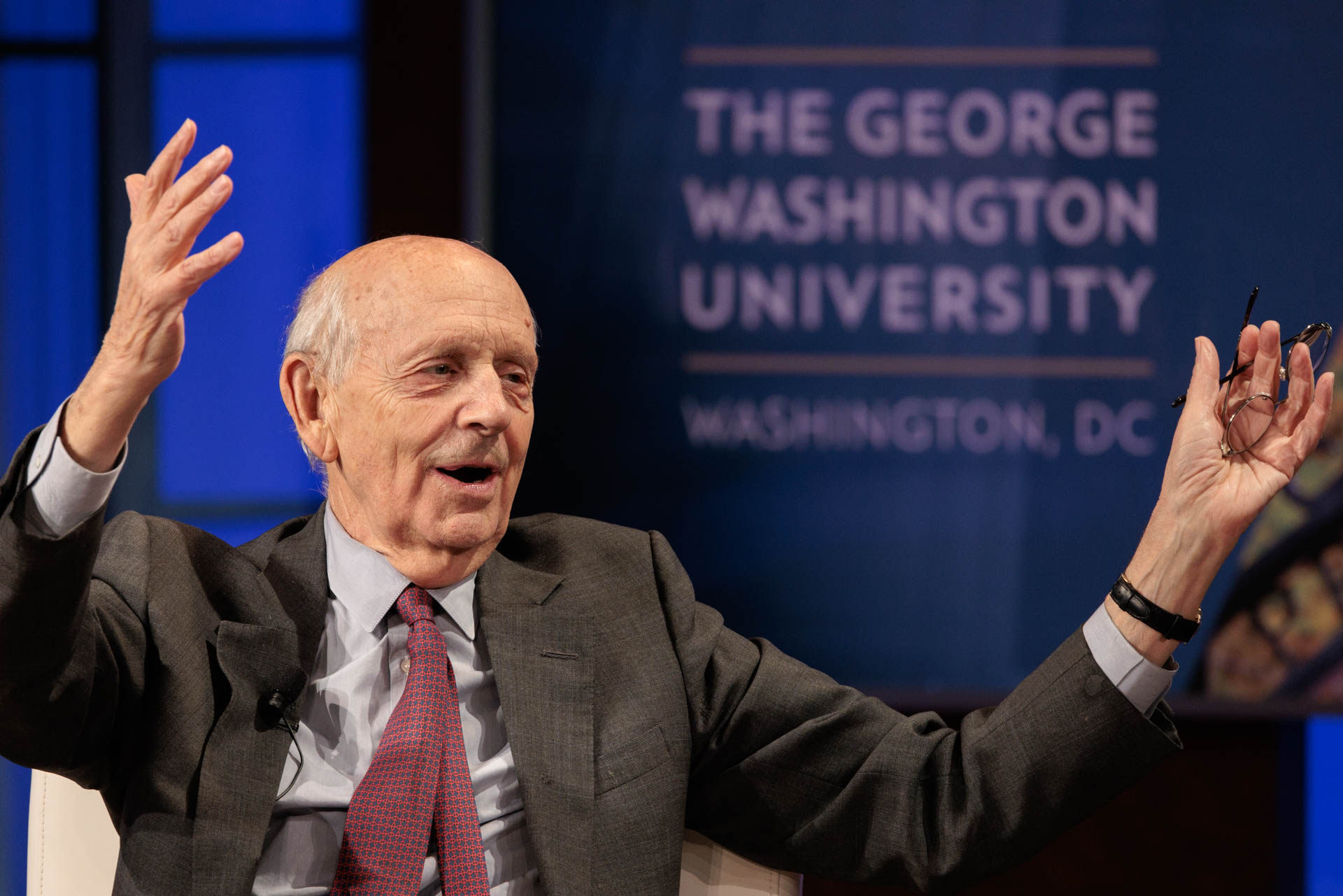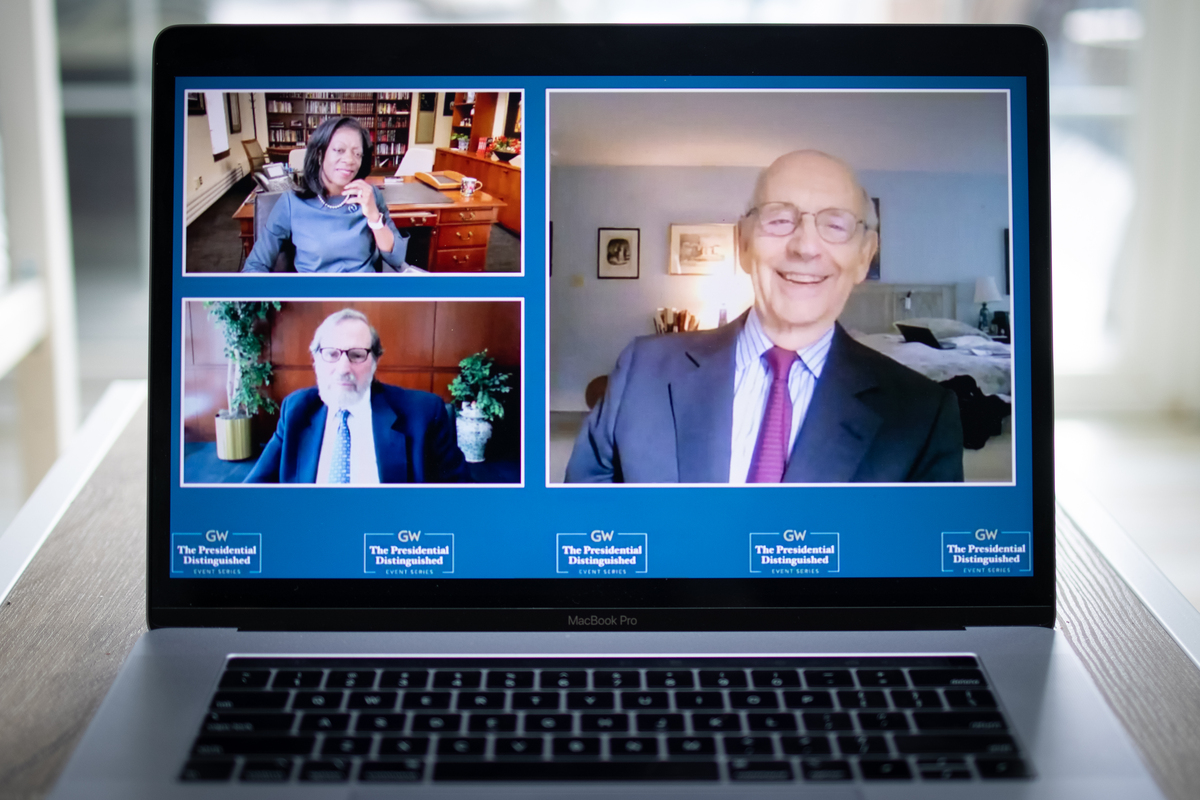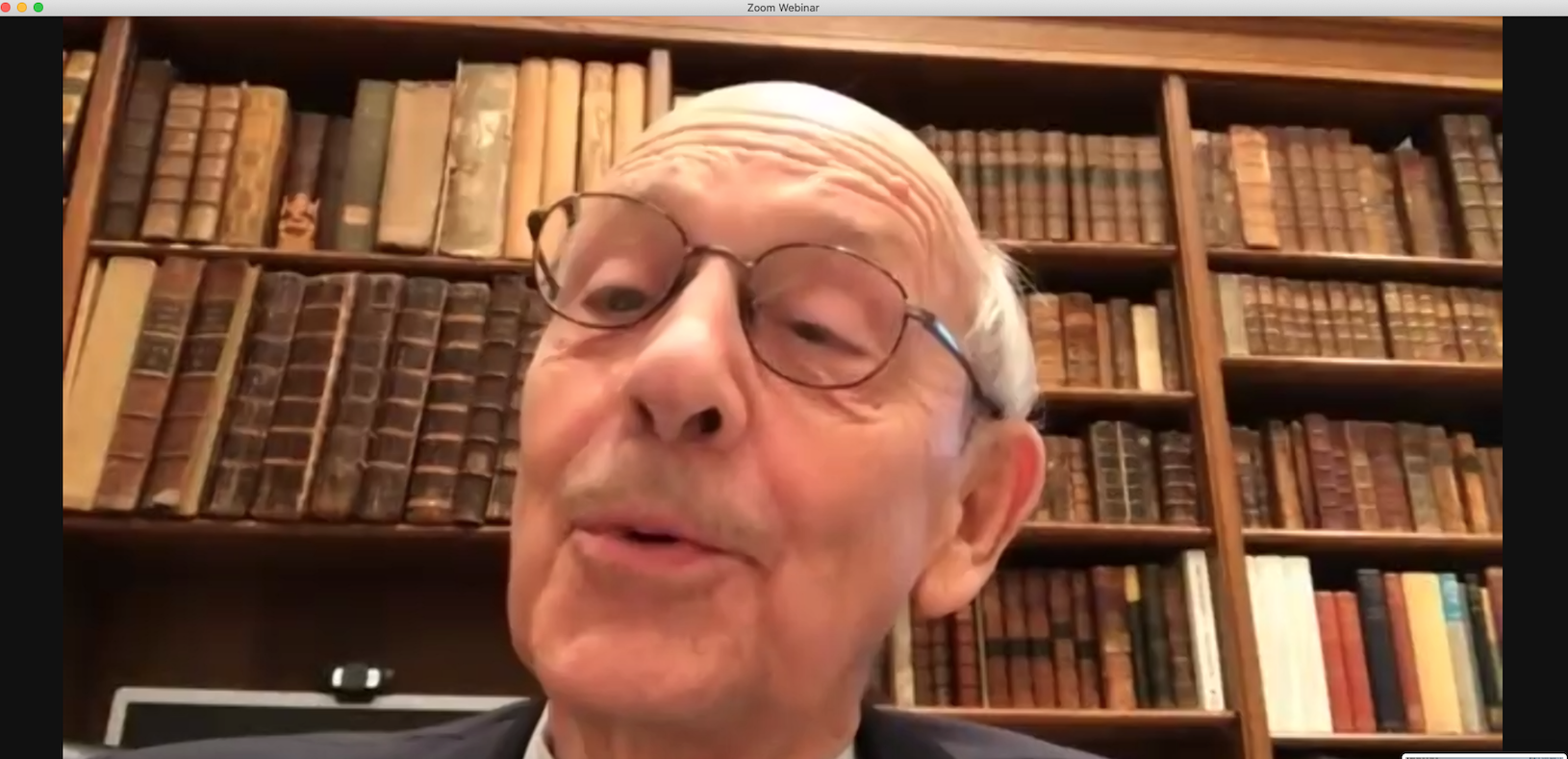The second in a series of five planned conversations with retired U.S. Supreme Court Justice Stephen Breyer took place Tuesday on the George Washington University campus. The conversations are intended as an oral history of Justice Breyer’s career.
President Mark S. Wrighton delivered brief remarks introducing Justice Breyer and moderator Dayna Bowen Matthew, dean of GW Law.
“This is certainly a good example of what we call here at the university an ‘only at GW’ moment,” Wrighton said. He then outlined the conversation’s focal points, from Justice Breyer’s time at Harvard Law School both as a student and teacher, then as clerk to the late U.S. Supreme Court Justice Arthur Goldberg and concluding with the years he spent in the U.S. Department of Justice’s Antitrust Division.
Justice Breyer was appointed to the Supreme Court by President Bill Clinton in 1994 and served for 28 years until his retirement last June.
“Lest anyone think Justice Breyer has really retired,” Wrighton said, “he’s now working on his eighth published book, not counting textbooks, while also teaching a couple of courses at Harvard, continuing to give talks in many locations and working on projects for the American Bar Association and others. Clearly, he’s not retired.”
Dean Matthew, Wrighton said, “also has had a distinguished career, if not quite as long as Justice Breyer’s. I have come to know her as a great leader here at GW, and I value very much the opportunity to work with her.”
Matthew began the conversation by asking, “What made you choose Harvard?” Justice Breyer joked that since he had grown up in San Francisco and done his undergraduate work close to home (at Stanford) before going to England to study at Oxford, Harvard was an attractive location “halfway” between his two previous universities.
The atmosphere at Harvard Law in the early 1960s, Justice Breyer said, was more difficult for women than he recognized at the time. As a law student, he thought it was “ridiculous” that there were so few women admitted—fewer than 20 of his classmates were women, while more than 500 were men. At least one professor, Barton Leach, refused to call on a woman in class. Erwin Griswold, who was dean of Harvard Law School in those years, invited women students to dinner and then asked them why they had come to Harvard, taking the place of a man. Justice Breyer recalled that one of those women, Ann Dudley, responded, “Because I couldn’t get into Yale.”
Recommending the book “Pinstripes & Pearls” (Scribner, 2003) written by his classmate Judith Richards Hope, Justice Breyer said, “It’s important to remember that time.”
After graduating from Harvard Law School, Justice Breyer began working as a clerk to U.S. Supreme Court Justice Arthur Goldberg.
“Goldberg was wonderful to work for,” the justice said. “We went to his house for dinner several times. We would sit around and sing labor songs.” Here, he broke briefly into song: “You can’t hurt me, I’m working for the union,” before saying, “I’ll spare you my voice.”
When he went to work for Justice Goldberg, Justice Breyer said, 10 years had elapsed since the Supreme Court had outlawed segregated schools in its Brown v. Board of Education ruling. But the situation on the ground was changing slowly, if at all. When Arkansas Governor Orville Faubus defied the order to integrate schools in his state, President Dwight Eisenhower sent federal troops to Little Rock.
“I think it was the best thing Eisenhower ever did,” Justice Breyer said. The mission of the Supreme Court at that time, he added, “was to get Brown enforced.”
Sensing an opportunity, Matthew asked about the current court and some of its pending decisions.
“We’re not supposed to talk about the court you served on, but I can’t resist since race is at the center of some of the most important decisions about to be decided by the court,” Matthew said. “What should we expect?”
The justice politely declined to answer, in part, he explained, because he should not discuss cases before the court, and because, he added, “I don’t know. We’ll find out.”
“You know I had to ask,” Matthew said.
“There’s no problem with your asking anything you would like to ask,” Justice Breyer said. “The problem comes up if I choose to answer.”
Alluding to the turmoil in American culture in the period under discussion, given the war in Vietnam, the modern Civil Rights Movement and other milestones of the 1960s, Justice Breyer said, “It was not an easy time. Not at all.” Today, he added, “I hope we get together and sort of stop what’s going on now, but the Vietnam period we survived.”
Justice Breyer suggested a philosophical view of American politics as perpetually struggling to achieve some kind of equilibrium. His comments similarly veered from serious historical reflection to humorous anecdotes.
“It was fun” working as special assistant to the late Donald Turner, assistant attorney general in charge of the Antitrust Division from 1965-68, he said. He recalled one day when Turner took a black crayon and wrote on the bottom of a “most wanted” poster: “Portrait of J. Edgar Hoover as a young man.”
Justice Breyer characterized the role he played in the Watergate prosecutions as “minor,” adding, “Archibald Cox was a truly great man in my opinion.” Cox, the first special prosecutor in the Watergate affair, assigned Justice Breyer to investigate the so-called “Dita Beard memo” which referred to alleged efforts by officials at ITT to influence the antitrust case against their corporation by making illegal campaign contributions.
“I was lucky, very lucky, I would say, in the people I worked for,” Justice Breyer said. “I was lucky working with Goldberg, lucky working with Archibald Cox and with Ted Kennedy.”
Before adjourning for a reception, Matthew asked Justice Breyer a few questions submitted in advance by students.
“If you could go back when you were in law school and give yourself one piece of advice,” one asked, “what would it be?"
It would be to “calm down,” Justice Breyer said. “You can only know about five percent of what you’d like to know, and maybe three percent of what you ought to know about the jobs that you choose among. Choose, and then your life builds itself around that.”
Another student asked for tips for being a successful judicial law clerk.
“Do the work that you’re asked to do,” Justice Breyer said, once again eliciting laughter. “That’s extremely helpful to the judge.”
A final question alluded to an influential memorandum written by Justice Goldberg arguing against the death penalty and asked if Justice Breyer agreed or disagreed with Justice Goldberg’s position.
“It’s unfortunately not possible, in my opinion, to have a fair administration of the death penalty,” Justice Breyer said, “and therefore there’s a reason for reconsidering it.”
Future conversations in the series will be hosted by a moderator who will interview Justice Breyer about the phases of his life. Topics of future conversations, with dates to be announced, include Justice Breyer’s time working for Senator Ted Kennedy, his work as a judge on the U.S. Court of Appeals for the First Circuit and with the Sentencing Commission and his years on the Supreme Court of the United States.
The series began in March with a conversation moderated by Alan B. Morrison, Lerner Family Associate Dean for Public Interest and Public Service Law, in which Justice Breyer and his brother, Senior District Judge Charles R. Breyer, recalled their childhood.






